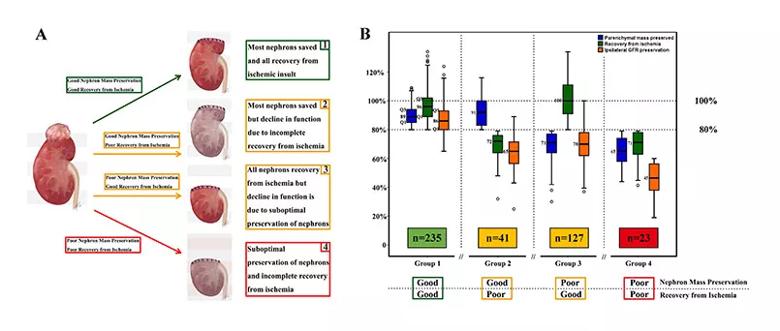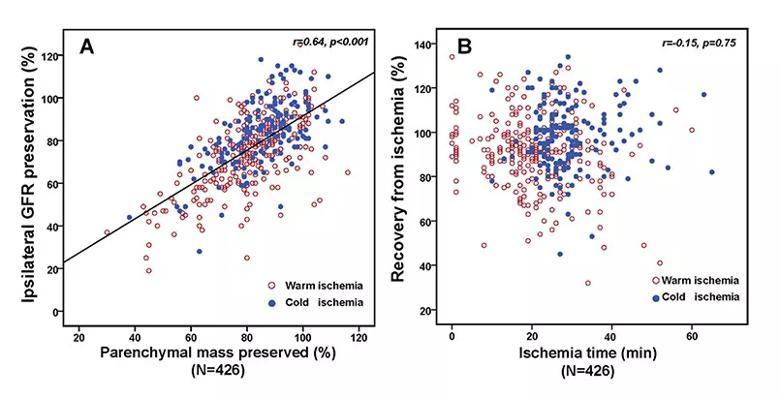Advertisement

Research fellow Jitao Wu, MD, and urologic oncologist Steven C. Campbell, MD, PhD, Cleveland Clinic Glickman Urological and Kidney Institute, presented their research into parenchymal mass preservation during partial nephrectomy at the American Urological Association’s 2017 annual meeting. In this Q&A, Drs. Campbell and Wu offer pertinent details.
Advertisement
Cleveland Clinic is a non-profit academic medical center. Advertising on our site helps support our mission. We do not endorse non-Cleveland Clinic products or services. Policy
Q: What was the goal of your study?
Vascularized parenchymal mass preservation (VPMP) can be measured before and after partial nephrectomy (PN) and appears to be an important contributor to functional outcomes. In this study, we assessed the functional impact of VPMP in a large cohort of patients and evaluated potential predictive factors.
Q: What prompted this investigation?
Ischemia, which has been studied extensively, was previously considered a strong predictor of functional outcomes after partial nephrectomy. However, off-clamp or segmental clamping techniques have been evaluated to eliminate ischemia from the equation, but have not substantially improved functional outcomes.
More recent research suggests that cold ischemia is protective and essentially insensitive to duration of ischemia, while limited warm ischemia may not have significant impact on overall functional recovery.
In recent years, another factor has come into focus, namely the amount of healthy parenchyma removed during tumor resection. We have come to recognize that volume of VPMP is a critical predictor of functional outcomes after PN. However, studies consisted of relatively limited numbers of patients and the predictors of VPMP remained unclear. We recognized the need for additional research.
Advertisement
Q: Describe your research parameters.
We analyzed data from 426 patients managed with PN for a renal mass at Cleveland Clinic. VPMP was measured from CT scans <2 months prior and 3-12 months after PN. Renal function was estimated by glomerular filtration rate (GFR), using the MDRD-2 formula. Patients with two kidneys were required to have nuclear renal scans to assess split renal function within similar timeframes, and all analyses focused on the kidney exposed to ischemia. Recovery from ischemia was defined as percent GFR preserved in the operated kidney normalized by percent VPMP. Pearson correlation evaluated the relationship between renal function preservation and VPMP. Multivariable logistic regression assessed predictors for VPMP. (See Figures 1 and 2 below.)
Q: And your results?
Eighty-eight patients (20.7 percent) had a solitary kidney and 338 patients (79.3 percent) had a contralateral kidney. Median tumor size was 3.4 cm and median R.E.N.A.L. score was 8. Cold ischemia was utilized in 159 patients; warm ischemia in 267. Median ischemia times were 27 and 20 minutes, respectively.
Median preoperative vascularized parenchymal mass in the operated kidney was 195 cm3 (IQR: 153-245) and median postoperative vascularized parenchymal mass was 157 cm3 (IQR: 122-201), resulting in median 84 percent VPMP.
Pearson’s correlation analysis showed that GFR preservation correlated strongly with VPMP (r=0.64, p<0.001). Recovery from ischemia was suboptimal (<80 percent) in 64 patients (15 percent of cohort), while suboptimal VPMP (<80 percent) was a more common adverse event, occurring in 150 patients (35 percent) (p<0.05).
Multivariable analysis demonstrated that increased tumor size and R.E.N.A.L. score correlated with reduced VPMP (p=0.027 and <0.001, respectively), and solitary kidney status correlated with increased VPMP (p=0.005).
Q: Explain the significance of your findings.
Our data suggest that VPMP correlates strongly with functional outcomes after PN. Evidence suggests that most nephrons make a strong recovery from the ischemic insult related to PN, as long as prolonged warm ischemia has been avoided. In this setting, preservation of vascularized nephron mass is the primary determinant of functional recovery. Larger tumor size and increased tumor complexity correlate with reduced VPMP, while VPMP tended to be greater for solitary kidneys. This suggests that VPMP is a modifiable factor and that it can be optimized when it is most important — in patients with a solitary kidney.
Q: How might your findings impact surgical procedures?
Our study may have implications for surgical technique as it suggests that the amount of VPMP, rather than ischemia, may be more important for functional recovery after PN.
We know that loss of nephron mass is primarily the result of two issues – excised parenchymal mass (EPM) that occurs during the excisional phase of the procedure and devascularized parenchymal mass (DPM) related to renal reconstruction. Excisional techniques should focus on minimal but negative margins, while the reconstructive phase of PN may be more important for functional recovery. Sutures placed to prevent postoperative bleeding or urine leak and to close the capsule should be placed in a careful and discriminant manner to avoid devascularizing too much nephron mass.
Advertisement
Our research suggests that precision of reconstruction of the kidney is most important for preserving function after PN, although further studies will be required.

Figure 1. A) In an effort to assess the functional outcomes in the operated kidney, four potential scenarios were considered (Groups 1-4) based upon degree of nephron mass preservation and recovery from ischemia. B) The incidence of each of these four scenarios was defined, with “good” indicating outcomes of ≥80 percent, and “poor” representing outcomes of <80 percent. Box plots show median values with interquartile ranges. Extreme values, defined as those more than 1.5 x (Q3-Q1) away from either Q1 or Q3, are shown as individual points.

Figure 2. Determinants of functional outcomes after partial nephrectomy (PN) with analysis of parenchymal mass preservation and ischemia. All analyses are focused on the ipsilateral kidney. A) Relationship between parenchymal mass preservation and GFR preserved. B) Relationship between ischemia time and recovery from ischemia, which normalizes for parenchymal mass preservation. Pearson correlation analysis was utilized for these comparisons.
Advertisement
Advertisement

Polygenic risk score could help predict who will develop this aggressive breast cancer

New guidelines offer insight into emerging therapies, dental issues and more

Clinical trial to assess the value of nutritional, physical therapy and social supports prior to preoperative chemotherapy

Research demonstrates improved overall survival for patients receiving comprehensive treatment for breast cancer in addition to radiation or surgical intervention for brain cancer

Platinum-eligible phase 3 trial of enfortumab vedotin and pembrolizumab yields ‘unprecedented data’

Cleveland Clinic Cancer Institute brings multidisciplinary care, precision oncology and clinical research to the United Arab Emirates

Extent of baseline burden impacts progression-free and overall survival

Further study warranted to better understand the clinical implications of these findings